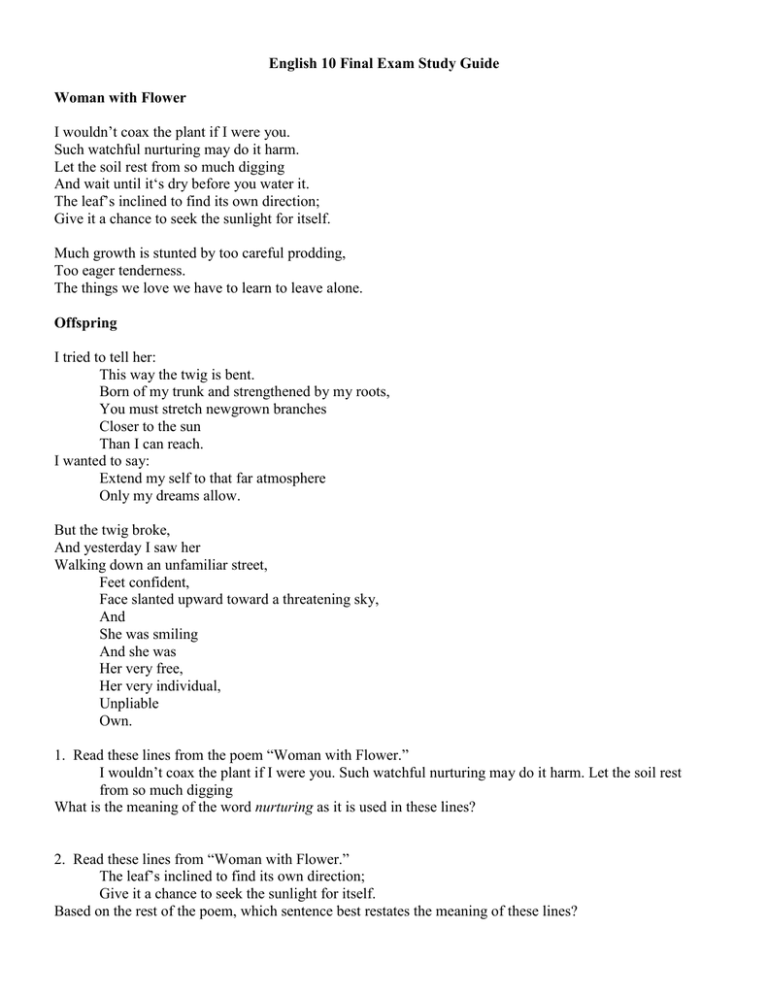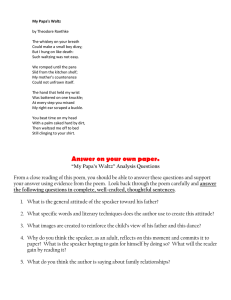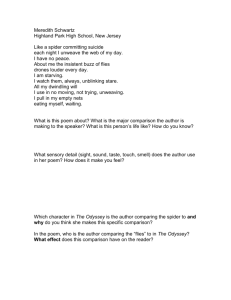English 10 Final Exam Study Guide Woman with Flower I wouldn't
advertisement

English 10 Final Exam Study Guide Woman with Flower I wouldn’t coax the plant if I were you. Such watchful nurturing may do it harm. Let the soil rest from so much digging And wait until it‘s dry before you water it. The leaf’s inclined to find its own direction; Give it a chance to seek the sunlight for itself. Much growth is stunted by too careful prodding, Too eager tenderness. The things we love we have to learn to leave alone. Offspring I tried to tell her: This way the twig is bent. Born of my trunk and strengthened by my roots, You must stretch newgrown branches Closer to the sun Than I can reach. I wanted to say: Extend my self to that far atmosphere Only my dreams allow. But the twig broke, And yesterday I saw her Walking down an unfamiliar street, Feet confident, Face slanted upward toward a threatening sky, And She was smiling And she was Her very free, Her very individual, Unpliable Own. 1. Read these lines from the poem “Woman with Flower.” I wouldn’t coax the plant if I were you. Such watchful nurturing may do it harm. Let the soil rest from so much digging What is the meaning of the word nurturing as it is used in these lines? 2. Read these lines from “Woman with Flower.” The leaf’s inclined to find its own direction; Give it a chance to seek the sunlight for itself. Based on the rest of the poem, which sentence best restates the meaning of these lines? 3. The author of “Woman with Flower” suggests that “Too eager tenderness” will most likely 4. Which word best describes the tone of “Woman with Flower”? 5. The speaker of “Offspring” does not refer to herself in the last 10 lines of the poem. Why does the author most likely structure the poem in this way? 6. Which phrase best describes both the gardener in “Woman with Flower” and the speaker of “Offspring”? 7. Which line from the poems best expresses the theme of both “Woman with Flower” and “Offspring”? Fog The fog comes on little cat feet. It sits looking over harbor and city on silent haunches and then moves on. 8. What type of literary device is being used in this poem? 9. What is alliteration and assonance? 10. What does imagery refer to? 11. What is the difference between similes and metaphors? 12. What is onomatopoeia? 13. Repeated use of sounds, words, or ideas for effect and emphasis is: 14. A poem with no set meter or rhyme scheme is _____________________________________________ 15. What is personification? 16. What theme, or central idea, is expressed in “All”? 17. What is the best theme for “Also All”? 18. What is the meaning of the following lines from “Also All”? Not every song / will drift past every ear and heart. 19. What does the speaker in “Also All” believe about the future? 20. Why do poets use sound devices in their poems? 21. Why do poets use figurative language in their poems? 22. What feeling is conveyed by the imagery in “The Guitar”? 23. To what is “The Guitar” compared? 24. Why does the speaker of “The Guitar” love the instrument? 25. What are the main characteristics of the tanka form? 26. What subject (s) does the tanka form usually include? 27. How is the tanka form mainly identified? 28. What does the tanka “When I went to visit . . .” describe? 29. What does the speaker of “When I went to visit . . .” hint at, or suggest, in the poem? 30. In “The clustering clouds . . .” what image does the speaker contrast with the clouds? 31. On what conflict does “The clustering clouds . . .” focus? 32. What are the main characteristics of the sonnet form? 33. In “The Bean Eaters,” why does Brooks choose beans as the couple’s main food? 34. Based on the following lines from “The Beans Eaters,” what feeling does Brooks have toward her subjects? Two who are Mostly Good. Two who have lived their day, But keep on putting on their clothes And putting things away 35. In “The Bean Eaters,” what is the couple doing as they eat? 36. In “The Bean Eaters,” what does Brooks mean when she writes that the couple remembers “with twinklings and twinges”? 37. In “Conscientious Objector,” who is the speaker’s adversary? 38. What is the tone of “Conscientious Objector”? 39. Which of these lines from “Conscientious Objector” contains an example of personification? 40. Who are the speakers of “In Flanders Fields”? 41. What are the speakers asking of the reader in these lines from “In Flanders Fields”? To you from falling hands we throw / The torch; be yours to hold it high.





